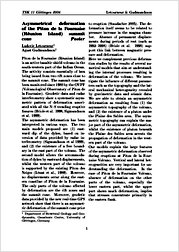Asymmetrical deformation of the Piton de la Fournaise (Réunion Island) summit cone
Letourneur, Ludovic
Gudmundsson, Agust
Universitätsverlag Göttingen
Sammelband- / Konferenzbeitrag
Verlagsversion
Deutsch
Letourneur, Ludovic; Gudmundsson, Agust, 2006: Asymmetrical deformation of the Piton de la Fournaise (Réunion Island) summit cone. In: Philipp, S.; Leiss, B; Vollbrecht, A.; Tanner, D.; Gudmundsson, A. (eds.): 11. Symposium "Tektonik, Struktur- und Kristallingeologie"; 2006, Univ.-Verl. Göttingen, S. 130 - 132., , DOI: 10.23689/fidgeo-1868.
 |
Dokument öffnen: |
Piton de la Fournaise (Réunion Island)
is an active basaltic shield volcano in the
south-western part of the Indian Ocean.
The activity consists essentially of lava
being issued from two rift zones close to
the summit cone. The summit cone has
been monitored since 1980 by the OVPF
(Volcanological Observatory of Piton de
la Fournaise). Geodetic data and radar
interferometry show a systematic asymmetric
pattern of deformation associated
with all the N–S trending eruptive
fissures (Briole et al. 1998, Sigmundsson
et al. 1999).
The asymmetric deformation has been
interpreted in various ways. The two
main models proposed are (1) eastward
dip of the dykes, based on inversion
of data provided by radar interferometry
(Sigmundsson et al 1999),
and (2) the existence of a free boundary
in the east part of the volcano. The
second model allows the accommodation
of dykes by eastward displacements,
whilst the western part of the volcano
is supported by the existing Piton des
Neiges (Lénat et al., 1989). However,no displacements occur along the eastern
coastline of Piton de la Fournaise.
The only parts of the volcano affected
by deformation are the rift zones and
the summit cone. Moreover, geodetic
data provided by the new real-time GPS
network show that there is an asymmetric
deformation of the summit cone prior
to eruption (Staudacher 2005). The deformation
itself seems to be related to
pressure increase in the magma chamber.
Absence of permanent displacements
during periods of rest (such as
1992–1998) (Briole et al. 1998) support
this link between magmatic pressure
and deformation.
Here we complement previous deformation
studies by the results of several numerical
models that aim at understanding
the internal processes resulting in
deformation of the volcano...

